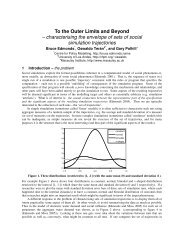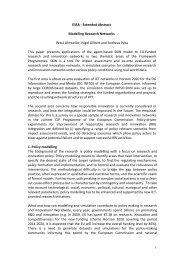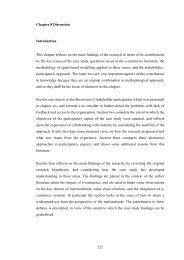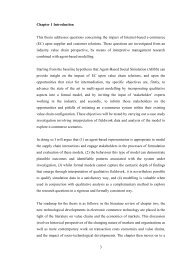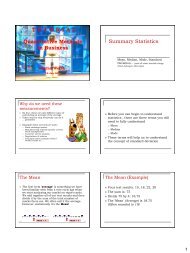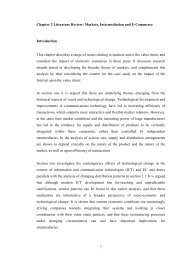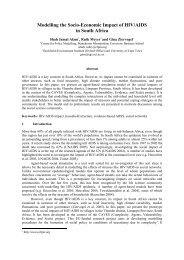1 Agent-Based Modelling Incorporating Qualitative and Quantitative ...
1 Agent-Based Modelling Incorporating Qualitative and Quantitative ...
1 Agent-Based Modelling Incorporating Qualitative and Quantitative ...
You also want an ePaper? Increase the reach of your titles
YUMPU automatically turns print PDFs into web optimized ePapers that Google loves.
saturation point after about thirty cycles. This is an important result because it shows that the model<br />
exhibits an outcome resembling a pattern identified in empirical studies of technology diffusion.<br />
We carried out a sensitivity analysis to test the robustness of the model to changes in program<br />
implementation: in the poorly validated model assumptions, <strong>and</strong> in the parametric values used. The<br />
first test examined various grid sizes, <strong>and</strong> hence different densities, for the small model. The grid<br />
was varied in size from 35 square cells to 55 cells, in steps of five. In all cases we found the market<br />
share for intermediaries to be very similar to that illustrated in Figure 7. The main difference was in<br />
the lower number of known suppliers, with the sparseness the grid reducing social cohesion in the<br />
value chain. Secondly, we looked at the effect of changing the distribution of initial perceptions.<br />
Whilst many important perceptions have been identified, far less is known about the distribution of<br />
those attitudes. We changed the parameter governing the probability an agent has initial perceptions<br />
about EC, <strong>and</strong> found little notable difference, except that the speed of adoption was a little slower.<br />
These results demonstrate robustness to small changes of this type. We can therefore conclude that<br />
such details are not critical to the model: sensitivity does not appear to be problematic.<br />
We examined the simulation results concerning intermediary success (market share, profitability<br />
<strong>and</strong> survival rate) with respect to their characteristics of pricing <strong>and</strong> technical competence. It should<br />
be noted here that intermediaries do not have dynamic strategies for adjusting these characteristics<br />
during simulation runs. We found that profitability is strongly correlated to intermediaries’<br />
technical competence, but it is not correlated to intermediaries’ selling price. As the six most<br />
profitable intermediaries are all those with high technical competence, it is clear that this<br />
characteristic is a decisive factor in the success of intermediaries. Eight out of the next ten highest<br />
(i.e. the 7 th to the 16 th in the ordering) had a medium level of competence. In contrast, the price<br />
characteristic shows no clear pattern of correlation with profitability. Market share is closely related<br />
to price, but due to variability in intermediary mark-up, agents with large sales are not necessarily<br />
the most profitable. Very low price (below 80 units or 20% discount) intermediaries are ordered as<br />
2 nd , 7 th , 8 th <strong>and</strong> 14 th most profitable, which is only slightly better than average success rate. In<br />
addition, the two agents that did not survive in this simulation both had tech. competence level of 1<br />
(low). This reinforces the conclusion that intermediary success correlates with competence.<br />
27




